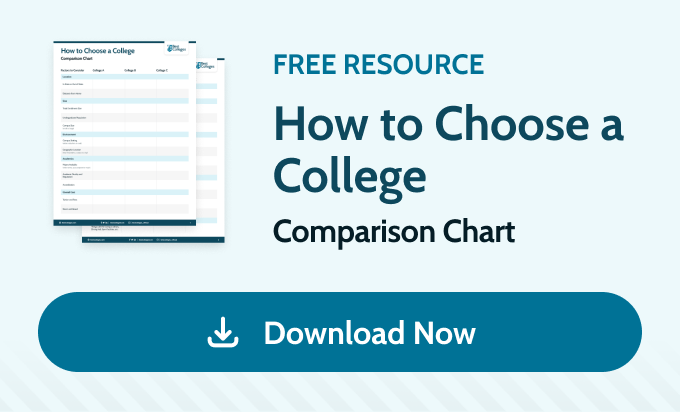How to Choose a College
Portions of the following article were drafted using an in-house natural language generation platform. The article was then reviewed, fact-checked, and edited by multiple members of our editorial team prior to publishing.
Choosing the right college is a critical decision that can shape your academic journey and future career prospects. From location and size to majors and reputation, there are several important factors to consider when making your decision.
We’ll discuss the key factors to keep in mind when choosing a college and offer helpful tips to help you make an informed decision. Whether you’re a high school student or a transfer student, here’s how to choose the right college for you.
What to Consider When Choosing a College
Picking which college to attend is a significant decision in your educational journey. While everyone has different needs and interests, you should consider the following factors to help inform your decision.
Location
For many students, location is one of the most significant factors in choosing a college. If you decide to stay in your home state and attend a public school, you can qualify for in-state tuition, potentially saving you a lot of money on college. Your proximity to home also affects how often you can visit family and friends and the cost and convenience of travel.
You should also consider whether you prefer an urban, suburban, or rural setting, as each offers different amenities, extracurricular activities, and general lifestyle.
Small college towns often offer a more intimate sense of community that lets you build strong relationships with peers and professors. In contrast, schools in large cities can grant you access to more social and cultural activities, not to mention internships with major companies and nonprofits.
Size
Colleges and universities come in all sizes, from small liberal arts colleges with fewer than 1,000 students to big state universities that enroll over 50,000 students annually.
Students with clear interests and goals tend to thrive at big universities because they can take advantage of the diversity in coursework, activities, and professional resources. Larger schools often maintain well-stocked libraries, state-of-the-art research facilities, and nationally recognized sports teams.
Pros & Cons of Attending a Large College
Pros
A wider range of academic programs and financial aid opportunities
A broad spectrum of clubs, organizations, and sports teams
More advanced research facilities and opportunities
Extensive alumni network
Cons
Introductory courses have hundreds of students and can be difficult to get into
The size of the campus and student population can be intimidating for some students
Less personalized support and access to resources
While small schools may not offer as many programs as large universities, they often provide specialized degrees — including self-designed majors — and hands-on learning opportunities. Small colleges can also mean smaller class sizes, allowing you to easily access one-on-one support from professors and academic advisors.
Pros & Cons of Attending a Small College
Pros
Smaller class sizes and more personalized attention from professors
Close-knit community and easier opportunities to build lasting relationships
Professors often know students by name and can offer tailored academic support
Students often have access to dedicated advisers and mentors
Cons
Smaller colleges may not offer as many academic programs or research opportunities
There may be fewer clubs and organizations to join or fewer events to attend
The smaller student body might limit social interactions and cultural diversity
To determine the best fit, visit both large and small colleges to get a feel for the campus atmosphere, reflect on whether you thrived in a large or small high school setting, and think about what aspects of college life are most important to you — whether it’s academic variety, research opportunities, or a close-knit community.
Ultimately, the decision comes down to your personal preferences and what environment you believe will best support your academic and personal growth.
Majors and Programs
Aligning your college choice with your academic and career interests can enhance your educational experience and better prepare you for your future career. For example, if you know that you want to study art history, you should only consider schools that offer this degree.
Specialized programs often provide better networking opportunities, internships, and resources that can help you succeed in your chosen field.
Conversely, attending a college without your desired major might limit your opportunities and require a transfer or additional time and money to switch paths.
Reputation
A college’s reputation can significantly influence your education and career opportunities.
Graduates from prestigious institutions often have access to a robust alumni network, increased internship opportunities, and higher starting salaries. Research indicates that Ivy League graduates, for instance, earn approximately 59% more than their counterparts from non-Ivy institutions, according to Payscale’s College Salary Report.
However, it’s important to note that while a prestigious college can offer many opportunities, success ultimately depends on your efforts and how you utilize available resources.
Campus Culture
Campus culture significantly influences your college experience by shaping your sense of community, social life, and overall well-being.
Key aspects to investigate include the diversity of the campus, availability of student services, types of social opportunities, campus traditions and events, and the general environment of the college.
Look for clubs and organizations in college and consider a diverse array of options, each contributing uniquely to your personal and professional development.
Sports and athletics also play a significant role in the college experience for many students. They can enhance school spirit, provide opportunities for personal growth, and offer a sense of community and belonging.
Tuition and Fees
Understanding the costs associated with attending college is crucial to making an informed decision. College costs not only include tuition and fees but also room and board, books and supplies, transportation, and personal expenses.
According to the National Center for Education Statistics, in-state residents attending a four-year public institution paid an average of $9,750 in tuition and fees in 2022-23, whereas out-of-state students paid $28,297. Private colleges, which do not consider residency status, charged learners an average of $35,248 in tuition and fees in 2022-23.
How to Compare Colleges and Narrow Your List
It’s not always easy deciding on a college to apply to or attend. The steps below aim to help you choose the right college and feel good about your decision.


Step 1: Make a College List
Early in the process, sit down with your parents/guardians or someone you trust, such as your school guidance counselor, to develop a list of colleges that interest you. This list can include public and private schools, both local and out-of-state.
You’ll want to consider a variety of experiences and outcomes before making a final decision. Ideally, this list should include 10-15 colleges, all of which should offer majors that align with your interests and professional goals.
Step 2: Rank Your Wants and Needs
Knowing what you want and need from the college experience can help whittle down your initial list of schools. For instance, you may want a Big 10 experience with a large student body and plenty of campus activities. Alternatively, a more intimate campus with a liberal arts background may better fit your needs.
Step 3: Visit College Campuses
The internet remains an incredible resource for researching colleges and universities, learning about degree programs, and getting to know faculty and staff. Still, looking at a school’s website does not provide the same insight as visiting the campus in person.
By exploring college campuses, you and your family can get a better feel for the institution’s culture, ask questions, eat in the cafeteria, and browse on-campus housing. See whether you can readily picture yourself attending.
Step 4: Compare Financial Aid Offers
After applying to the colleges on your shortlist, you must wait for acceptance letters and financial aid award letters to arrive. In addition to funding provided by the federal government through the FAFSA, you can receive financial aid packages from individual schools.
If you’re aiming to graduate with little to no debt, a higher financial aid package could be the determining factor that helps you pick a school. By evaluating financial aid award letters and comparing annual costs, you can get a clearer sense of your true out-of-pocket costs.
Step 5: Weigh the Pros and Cons of Each College
After completing the steps above, it’s time to sit down to weigh the pros and cons of each college and see which one best meets your criteria. For example, the school that offers the most money may allow for the least amount of debt, but what if it doesn’t offer a campus culture that aligns with your needs?
Gathering ample information about your target schools can better prepare you to choose your college and find an institution that’s the best fit for you.
Frequently Asked Questions About Choosing a College
According to most admissions experts, you should apply to 4-12 schools, depending on your application fee budget. You can divide schools into “reach,” “target,” and “safety” schools to help ensure you’re submitting applications to a balanced mix of institutions.
That said, some prospective students have a really good sense of the college or university they want to attend and don’t feel compelled to apply to multiple schools.
Ultimately, it is important to create a well-researched and balanced list that aligns with your goals and preferences while ensuring you can dedicate sufficient time and resources to each application.





